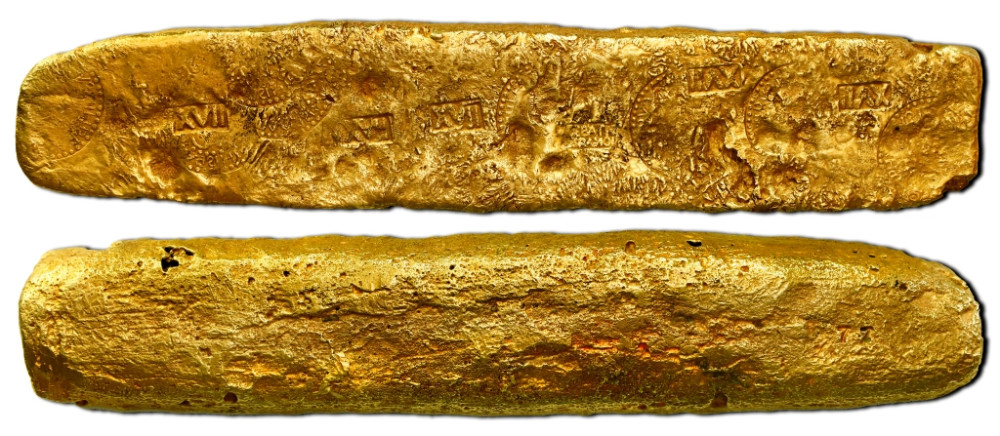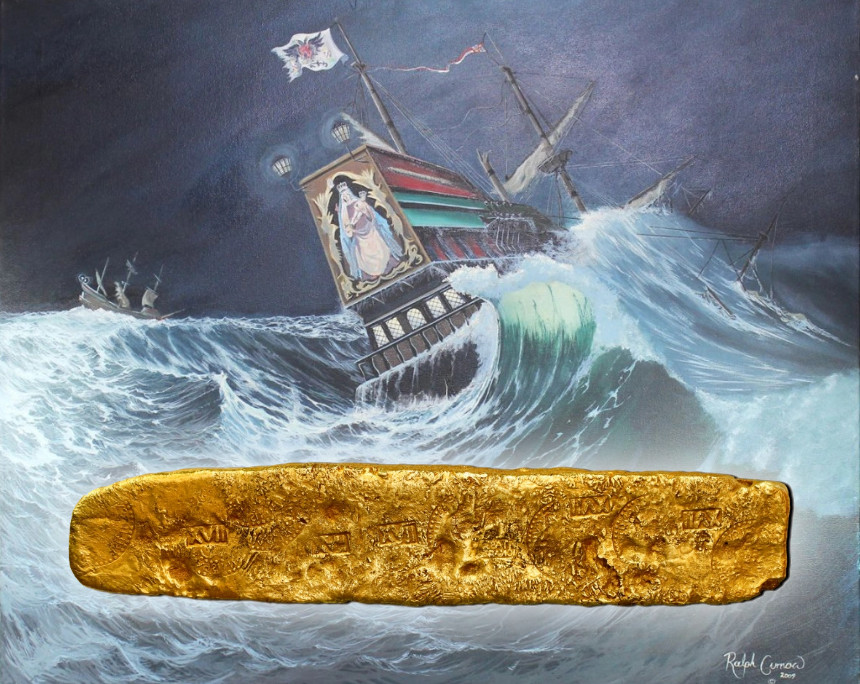Gold Bar from Famous Shipwreck Comes Under the Hammer
When the Spanish treasure galleon Nuestra Señora de Atocha sank in 1622 off what is now Key West, Florida, she took down untold treasures in gold and silver. And now a particularly famous piece of treasure from the wreck is crossing the auction block. One of the largest gold bars ever recovered from a Spanish colonial shipwreck is up for sale on May 7th in an auction conducted by Daniel Frank Sedwick, LLC in Winter Park, Florida.
The gold bar, listed in the sale as lot 96, weighs over 5 pounds (2,274 grams), measures 8-3/4” x 1-1/2” x ¾”, and consists of 17-karat gold mined in the New World. The unique bar features eight circular royal tax stamps bearing the King of Spain’s name as PHILIPPVS III along with five XVII (17-karat) gold fineness markings. The bar also possesses a single foundry and assayer mark reading SEBATN / ESPANOL at the center, a mark that is both unattributed and only found on two gold bars recovered from the Atocha. The gold bar’s pre-auction estimate is $200,000 and up.
“This Atocha gold bar is a crowning treasure piece from the most popular salvaged shipwreck treasure ever,” said Daniel Frank Sedwick, owner and founder of the auction firm. “With its high intrinsic value in Spanish colonial gold plus its incredible historical value, it will be a trophy piece for its next owner.”

Lot 96: Large gold ingot 77, 2274 grams, marked with fineness XVII (17K). From the Atocha (1622), with original Fisher photo-certificate 85A-GB077, pedigreed to the Christie’s Atocha auction of June 1988 (lot 90). Estimate: $400,000.
The gold bar was created in the early 1600s at a Spanish colonial foundry processing gold and silver mined throughout South America. After being transported overland to Panama City, this gold bar, among others, was loaded in mid-1622 aboard the Spanish treasure galleon Nuestra Señora de Atocha. The Atocha, a three-masted galleon constructed just two years prior, was to carry a vast treasure of gold and silver ingots, Colombian emeralds, and silver coins all bound for mainland Spain.
When the Atocha departed her final port at Havana, Cuba on September 4th, 1622, she was the almiranta, the lead ship, of the 28-ship 1622 Fleet. The Fleet was a vital link in Spain’s finances as the gold and silver from the New World funded the royal treasuries. In addition to the treasures on board, the Atocha carried her crew along with soldiers and passengers, around 265 people in all, intending to cross the Atlantic Ocean and return to Europe.
Just two days out from Havana, the Fleet was engulfed by a hurricane while approaching the Florida Straits. Amid the storm, the Atocha was wrecked and torn apart upon a reef off the Florida Keys. Only five people survived the sinking, having clung to the highest remaining mast of the ship as it sank. The wreck of the Atocha was further scattered just a month later during another storm, preventing the Spanish colonial authorities from salvaging any of her precious cargo spilled across the ocean floor.

A cannon of the Nuestra Señora de Atocha in the General Archive of the Indies in Seville. Image: Paul Hermans via Wikimedia Commons / CC BY-Sa 3.0.
The treasure of the Atocha did not see light again until 1971, when the first coins were found by the now-famous salvager Mel Fisher and his divers. Throughout legal battles and personal tragedies, the salvage group eventually recovered the bulk of the treasure in 1985 and thereby unleashed the largest supply of silver cobs and ingots the market has ever seen.
This gold bar will be auctioned along with its photo-certificate issued by the Fisher salvage company in 1985. The bar also boasts a pedigree to the Christie’s Atocha auction of June 1988 as lot 90.
Other treasures from the Atocha in the upcoming Sedwick auction include:
- a large silver ingot from Oruro weighing over 88 troy pounds (Lot 105) estimated at $30,000 and up.
- a silver ingot from Potosí weighing over 82 troy pounds (Lot 106) estimated at $25,000 and up.
- a very rare silver piña ingot, one of only three known from the Atocha, weighing 5,335 grams (Lot 107) estimated at $15,000 and up.
- over 180 silver coins from Potosí, Mexico City, and Lima including 19 high grade pieces from the Bill Barman Collection of Atocha Research Coins

This large silver “piña” ingot weighing 5,335 grams, one of just three recovered from the Atocha shipwreck, is also featured in auction.
“To have this amazing gold bar alongside all these other treasure pieces from Atochain a single auction is a feat not seen on this market in decades,” said Sedwick. “And it won’t be seen again anytime soon.”





